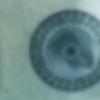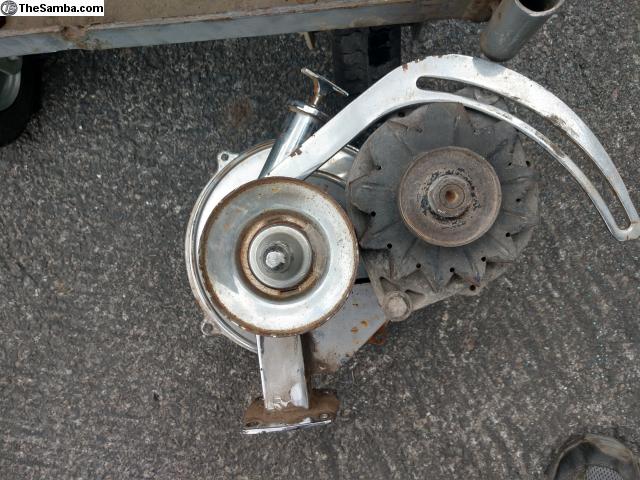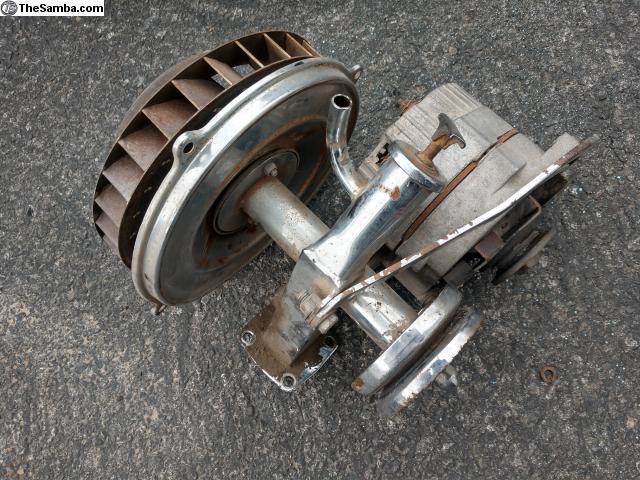On the topic of oil coolers, I don't see a good reason for keeping one inside the shroud. It just contributes to the heat load and temps inside the engine compartment. I got a 36hp shroud, blocked off the internal cooler and put in a thermostatically controled external cooler with a fan in the wheel well.
I'm absolutely tracking with you on this.
Over on TheSamba, they have a bi-yearly love-in for the stock cooling apparatus, and there's always some highly respected guy from North Saskatoon or Outer Elbonia or North Pole, AK who pipes up with a "I've got a 2.7L 12:1 engine and I run a stock T1 shroud and doghouse cooler and never had any issues".
He doesn't drive further than to the DQ for a $56.98 Blizzard or at all "when it's really hot out", and he's got no oil temperature gauge - but he just knows that the Sainted German Engineers had it all figured out. Nobody dares cross him, because he knew enough to build his 2.7L 12:1 T1, and nobody else did, so it passes from the experience of one guy in a cold climate and into the cannon of VW folklore and common-knowledge gospel.
Also, Gene Berg loved them on his 7:1 compression specials. Full stop. That alone is enough to end any argument.
The stock cooling system cannot be improved upon, or so goes the story. The Sainted German Engineers toiled for decades on this before God Almighty opened the heavens and descended down to Wolfsburg to hand them the knowledge directly. It was written on a little scroll and they ate it - it tasted like honey in their mouths but was bitter in their throats.
It's therefore as good as any air-cooled setup has ever or will ever be, whether the engine in question is a 1200 cc Typ 122 or a Pauter 3L. Heaven protect you from the Keepers of the Flame if you have the audacity to run a 911-style setup: the tar-and-feather treatment is is too mild for such heresy - apostates and witches must be burned at the stake, their bones scattered in the dung-heap.
I've run DTMs for years on strokers. They're cheesy bits of fiberglass for sure, but they seem to work really well. I put T4 coolers in them because that's what they're set up for - but the stand cooler seems like a real nothingburger to me. It really makes me wonder what an aftermarket (Scat or EMPI, I don't think there's a bit of difference) wide-fan, 36 hp "doghouse" shroud without the doghouse or attendant cooler would do.
I always thought this would make a neat science project for somebody, and now Michael has done it.
To continue the riff:
I really like the T1, and by that I mean that I REALLY like it. But, I've been on record many times as saying that the oiling system seems as if it was designed on a fine Friday afternoon in October, somewhere around 4:45, with the windows open in the office. The bier tent was already set up, the tubas were tuning up down in the square, and Oktoberfest was about to fire up. They could hear the giggles of the frauleins who were already tapping the kegs. The boss had told the team they needed to be done by 5:00. They finished by 5:00.
Either that, or they meant it as a joke, but either way - it seems less "ingenious" than "convoluted" to control temperature with viscosity among other things. Because one bypass spring was too bizarre for the ignoramuses who WEREN'T Sainted German Engineers to adequately appreciate, they added a second later on. Doubling down on bad decisions is what makes Germans German.
I'm just a high-school graduate from Nowhere, USA who always thought it seemed like it might be a better idea to cool the heads with air from the fan and the oil with (I don't know, and call me crazy) a dedicated OIL COOLER.
Jump back- an oil cooler just for oil? Separate from the head cooling? Why would anybody want that?
Those klever krauts couldn't do that though, it might have added $4 to the cost of the car, and Der Feurer might send them to the eastern front - so they piggybacked the cooling fan on the generator/alternator, and the oil cooling on the head cooling setup and saved the $4. For this they received the Iron Cross and all the cyanide they could eat down in the bunker with old AH.
I can almost hear them now, their voices echoing down through the decades. "Be glad we added an oil cooler at all! It was Friday in October. We blocked off the air to number 3, but whatcha-gonna-do?"
I'm sure it must have been just like that.





